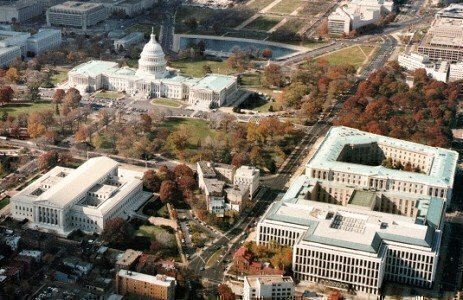A small but vocal contingent in the District of Columbia is pushing forward with plans for a summer local constitutional convention, with the goal of creating the 51st state. But significant political and legal barriers remain in the way.
 The efforts face long odds in the political reality of a divided Congress, where such a state with the District’s demographics would add more Democratic members to Congress. And several constitutional amendments may also be needed due to the District's unique status.
The efforts face long odds in the political reality of a divided Congress, where such a state with the District’s demographics would add more Democratic members to Congress. And several constitutional amendments may also be needed due to the District's unique status.
Currently, residents in the federal district have three electoral votes in the national presidential election, but no elected representatives in the House of Representatives or the Senate. Those two bodies have the final say over the federal district’s laws and budget.
Last week, a group led by the District’s mayor, Muriel Bowser, introduced a draft constitution for an area that would be called the state of New Columbia. Excluded from the 51st state would be property currently occupied by the White House, Congress, the Supreme Court and other federal buildings near the National Mall area. The rest of the current District would make up the new state.
Supporters have also pointed out that the District’s current population is bigger than that of two current states: Vermont and Wyoming. And they claim that District residents pay the largest proportion of federal taxes per person in the United States – without direct representation in Congress.
Link: Read The Draft Constitution
Under the draft constitution for New Columbia, the mayor would become the governor, while the current Council would become a state legislature. The document also contains some key differences from a state constitution proposed in 1982; the changes eliminate sweeping protections from discrimination and a guaranteed right to employment.
The group’s goal is to hold a mid-June constitutional convention, where residents can suggest document changes, and get a November 2016 referendum vote to approve an application for statehood.
That application, of course, would need to be presented to Congress, where it would most likely be a “dead letter” after a contentious national election year. And the group’s approach requires an act of Congress for state admission using a tactic called the Tennessee Plan.
Part of the problem, in addition to the political question of adding a new House member and two Senators, is the District’s history.
The District of Columbia was created by the Founding Fathers from land owned by the states of Maryland and Virginia, with the intention of setting up a safe, secure federal district. The Residence Act of 1790, which established a location on the Potomac River for the District.
The Founders were very clear to specify that the District of Columbia wasn’t a state, and its citizens had limited rights. Article I, Section 8 of the Constitution gave Congress the power to create a federal district to “become the Seat of the Government of the United States, and to exercise like Authority over all Places purchased by the Consent of the Legislature of the State in which the Same shall be, for the Erection of Forts, Magazines, Arsenals, dock-Yards, and other needful buildings.”
In 1973, Congress did give some governing powers to city officials when it passed the District of Columbia Home Rule Act. The Act called for a popularly elected city council and mayor. The District today is heavily Democratic, and its admission as a state would tilt the scales more to the Democrats’ liking in Congress.
Among the open constitutional questions are the need for at least one new federal constitutional amendment to make part of the federal district into a new state.
Since new states are entitled to three electoral votes and the District of Columbia already has three electors under the 23rd Amendment, another federal constitutional amendment could be needed to repeal the 23rd Amendment. Otherwise, the remaining federal district, consisting of historic and office buildings, would have few full-time residents and still have three electoral votes.
Also, there are questions about whether Maryland would need to approve the new state. And there is the argument considered by Attorney General Robert Kennedy back in the 1960s, when there was a move to incorporate the District within Maryland.
“While Congress' power to legislate for the District is a continuing power, its power to create the District by acceptance of cession contemplates a single act. The Constitution makes no provision for revocation of the act of acceptance, or for retrocession,” Kennedy argued in 1963, coming to the conclusion that a constitutional amendment would be needed.







